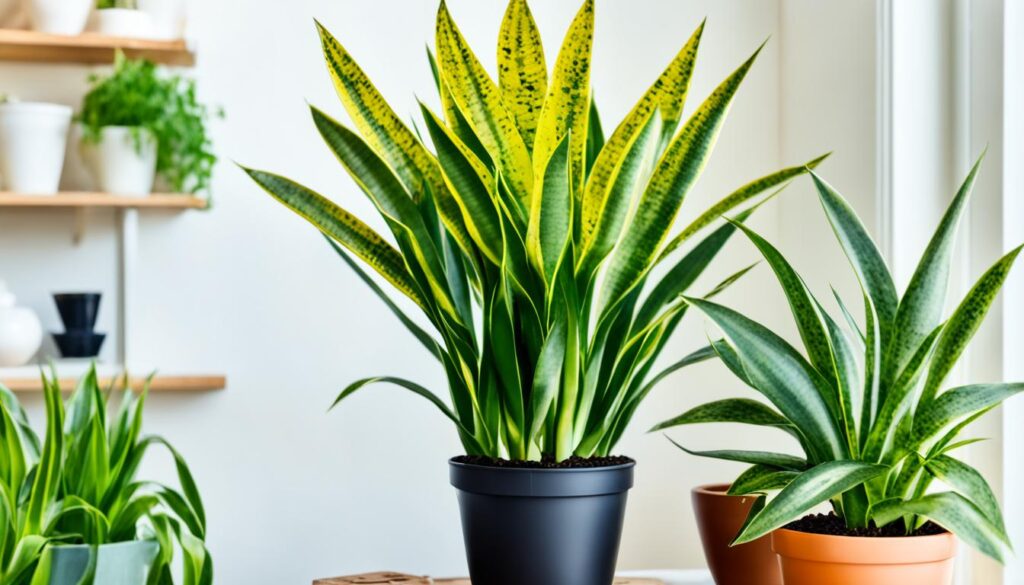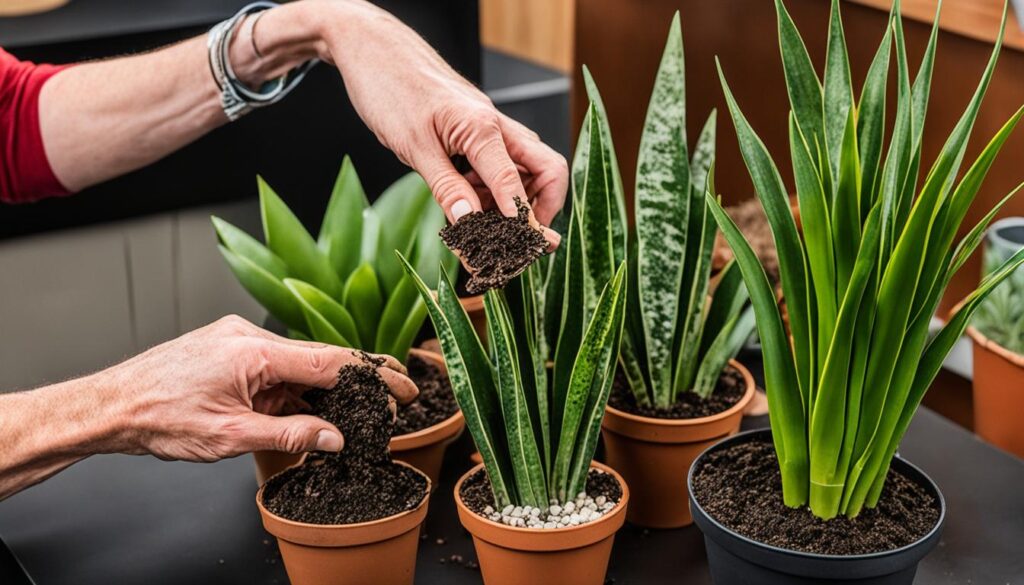Snake plant (Dracaena trifasciata), also known as Sansevieria and “Mother-in-Law’s Tongue,” is among the most popular indoor houseplants. Its tolerance to dry, tropical climates and easy growth through propogate snake plant, snake plant propagation, and propagating sansevieria make it an excellent choice for people starting their plant parenting journey. Propagating a snake plant is a simple process that lets you generate new plants at no cost or share them with your friends. The guide covers four proven methods: soil propagation, water propagation, propagation by division, and seed propagation. Successful propagation requires careful planning and consideration, including understanding when to propagate, gathering the essential tools, and providing the optimal environment for new plants to thrive.
Key Takeaways
- Snake plant propagation can take a couple of months before rooting or seeing new pups sprout.
- Division method is ideal for large, mature plants with many stems.
- Snake plants are best propagated during active growth in the spring and summer months.
- Propagating snake plants in water is not the preferred method due to risk of rot.
- Patience is key in propagating snake plants, as the process can take time.
Introduction to Snake Plant Propagation
Snake plant propagation is the process of creating new snake plants (Sansevieria) from existing ones. This versatile technique can be achieved through various methods, including taking leaf cuttings, dividing the plant’s rhizomes, or even growing snake plant babies from seeds. Propagating snake plants offers a range of benefits to both novice and experienced plant enthusiasts.
What is Snake Plant Propagation?
Snake plant propagation involves reproducing new plants from a parent snake plant (also known as Sansevieria or Mother-in-Law’s Tongue). This can be done by separating offsets, taking leaf cuttings, or growing the plant from seeds. The goal is to create genetically identical or diverse clones of the original plant, expanding your snake plant collection or sharing with friends and family.
Benefits of Propagating Snake Plants
Propagating snake plants provides several advantages. It allows you to grow your collection at no additional cost, as new plants are generated from the parent plant. This makes it an economical way to expand your indoor garden. Additionally, propagation enables you to share snake plant cuttings or divisions with others, fostering the joy of plant ownership. Finally, propagating from seeds can introduce genetic diversity, leading to subtle variations in leaf shape, color, or growth habits among the offspring.
Whether your goal is to multiply your snake plant collection, create unique specimens, or share the joy of plant parenting, mastering the art of snake plant propagation can be a rewarding and cost-effective endeavor.
When to Propagate Snake Plant
The spring and early summer months prove most favorable for propagating snake plants, coinciding with the plant’s active growth phase. During this time, the plant exhibits robust energy, promoting successful propagation. Avoid propagating during the dormant winter months when the plant’s energy is focused on root development rather than leaf growth.
Ideal Seasons for Propagation
Spring and early summer are the most favorable times to propagate a snake plant, as this aligns with the plant’s active growth period. The warmer temperatures and increased daylight hours provide the optimal conditions for new roots and stems to develop.
Signs of Readiness
To determine if your snake plant is ready for propagation, look for mature and healthy-looking leaves that are at least 4-6 inches tall, visible pups or offsets that can be separated, and a healthy root system. These indicators suggest the plant has the necessary resources to support the propagation process successfully.

Essential Tools for Snake Plant Propagation
Propagating a snake plant, also known as Sansevieria or “Mother-in-Law’s Tongue,” requires a few essential tools. To ensure a successful propagation process, you’ll need sharp knives, scissors, garden shears, or pruners for precise and clean cutting. Sanitize your cutting tool with alcohol beforehand to prevent the spread of diseases, and wear protective gear for safety. Additionally, you’ll need a well-established, healthy snake plant leaf, a planter or plant pot with drainage holes, potting soil to create an ideal environment for root growth, water, and a water-tight vessel for water propagation.
| Tools Needed to Propagate Snake Plant | Supplies for Propagating Snake Plant |
|---|---|
|
|
By ensuring you have the necessary tools needed to propagate snake plant and supplies for propagating snake plant, you’ll be well on your way to successfully growing more of these low-maintenance, air-purifying houseplants.
propogate snake plant: 4 Proven Methods
When it comes to propagating your beloved snake plant (Dracaena trifasciata), also known as Sansevieria or “Mother-in-Law’s Tongue,” there are four proven methods to consider: soil propagation, water propagation, propagation by division, and seed propagation. Each method offers its own unique advantages and requires specific techniques for successful implementation.
Soil Propagation
Soil propagation involves taking snake plant leaf cuttings and planting them directly in the soil. This method works best during the summer and spring months when the roots will develop faster. Simply snip off a healthy leaf, allow the cut end to callus over for a few days, and then plant it in a well-draining soil propagation medium, such as a cactus or succulent mix.
Water Propagation
Water propagation is often considered the easiest way to propagate a snake plant. This method involves placing snake plant leaf or root cuttings in water and allowing the roots to develop. While this water propagation process may be slower compared to other methods, it’s a great choice for beginners.
Propagation by Division
Dividing the mother plant’s root ball is a fast yet messier approach to snake plant division. Carefully remove the plant from its pot, then use a sharp, sterilized knife or pruners to divide the root ball into sections, ensuring each section has at least three rhizomes, a snake plant pup, or a leafy top. This propagation by division method allows you to generate multiple new plants from a single mother plant.
Seed Propagation
For those seeking to introduce genetic diversity, snake plant seed propagation is an option, although it’s a more patient process compared to the other methods. Collecting and germinating snake plant seeds can result in unique variations, but the success rate may vary.
Regardless of the propogate snake plant method you choose, following best practices and providing the right conditions for your new snake plant babies will help ensure their healthy growth and development.
Caring for Propagated Snake Plants
Providing the optimal environment is crucial for the well-being of your newly propagated snake plants. Use a well-drained potting mix, such as a cactus/succulent mix with pumice or perlite, to ensure proper aeration and prevent waterlogging. Snake plants thrive in bright, indirect light and a temperature range of 60-85°F (18-27°C).
Soil Requirements
When it comes to soil for propagated snake plants, well-draining potting mixes are essential. Cactus or succulent blends that contain amendments like perlite or pumice can help create the ideal aerated and nutrient-rich environment for your newly propagated plants to establish their roots and thrive.
Light and Temperature Needs
Light and temperature for propagated snake plants should mimic their natural habitat. Placing your propagated snake plants in a spot with bright, indirect sunlight will ensure they receive the right amount of illumination to support healthy growth. Maintaining a temperature range of 60-85°F (18-27°C) will also contribute to their overall vigor and development.
Watering Propagated Plants
When it comes to watering propagated snake plants, moderation is key. Water your new snake plants sparingly, allowing the soil to dry between waterings. Overwatering may cause root rot, while underwatering can lead to dehydration. Monitor the leaves for signs of over or underwatering and adjust your watering routine accordingly.

Troubleshooting Common Issues
While snake plants are generally easy to grow, they may still face various problems that are simple to fix. If your snake plant isn’t growing, it’s likely not getting enough snake plant growth issues. Ensure the plant is placed near a window or in a well-lit room. Overwatering can also cause the roots to rot, so water your snake plant in moderation and provide proper drainage. To combat snake plant rot and disease, use a suitable bactericide or fungicide. Common pests like mealybugs or spider mites can also affect snake plants, which can be treated with neem oil or insecticidal soap to address snake plant pests.
Addressing Slow Growth
If your snake plant isn’t growing as expected, the most common culprit is insufficient light exposure. Ensure the plant is placed in a spot that receives bright, indirect sunlight for at least 6 hours per day. Adjusting the lighting conditions can help promote healthy growth and address any snake plant growth issues.
Combating Rot and Disease
Overwatering is a primary cause of snake plant rot and disease. To prevent root rot, water your snake plant only when the soil has partially dried out, and ensure the pot has adequate drainage holes. If you notice signs of rotting or disease, treat the plant with a suitable bactericide or fungicide to help it recover.
Dealing with Pests
Common pests that can affect snake plants include mealybugs and spider mites. Regularly inspect your plant for any signs of snake plant pests and treat them promptly with a natural insecticide like neem oil or insecticidal soap. Maintaining good plant hygiene and humidity levels can also help deter pest infestations.
| Common Snake Plant Issues | Causes | Solutions |
|---|---|---|
| Slow Growth | Insufficient light | Provide bright, indirect sunlight |
| Root Rot | Overwatering | Let soil dry out between waterings, use well-draining pots |
| Pest Infestations | Mealybugs, spider mites | Use neem oil or insecticidal soap |
https://www.youtube.com/watch?v=FnShxIKP98c
Snake Plant Propagation for Kids
Involving children in propagating snake plant projects can be an excellent way to educate them about plants, responsibility, and the appreciation of nature. By having them participate in typical houseplant or garden chores, you can teach them about the main parts of a plant (roots, stem, leaves) and how they function. Depending on the child’s age and science background, you can introduce concepts like stem cells, differentiation, and the role of hormones in root growth. This hands-on activity can help combat “plant blindness” and foster a lifelong love and understanding of the plant world.
Educational Benefits
Teaching kids about snake plant propagation provides a valuable opportunity to engage them in the wonders of the natural world. Through the process of propagating snake plants, children can learn about the life cycle of plants, the importance of proper plant care, and the satisfaction of watching a new plant grow. This cultivates a sense of responsibility and appreciation for the environment that can have a lasting impact.
Age-Appropriate Activities
The level of involvement and complexity of propagating snake plant with kids can be tailored to suit different age groups. Younger children may enjoy the simple task of planting a leaf cutting or observing the growth of roots in water, while older children can delve deeper into the science behind propagation, such as understanding the role of hormones and cellular processes. Engaging children in these hands-on activities fosters a deeper understanding and connection to the plant world.

Conclusion
In conclusion, propagating snake plants is a simple and rewarding process that allows you to expand your collection, share plants with others, and introduce genetic diversity. By understanding the ideal seasons for propagation, gathering the essential tools, and mastering the four proven methods, you can successfully grow more of these low-maintenance, air-purifying houseplants. Proper care, including providing the right soil, light, and watering, is crucial for the long-term health and growth of your propagated snake plants. With patience and attention, you can enjoy the benefits of a thriving, expanded snake plant collection.
Whether you’re a seasoned plant enthusiast or just starting your snake plant propagation journey, this comprehensive guide has provided you with the necessary insights and strategies to successfully propagate and care for your snake plants. By following the steps outlined in this article, you can unlock the joy of watching your snake plant collection grow and flourish, all while contributing to a more sustainable and plant-filled environment.
The summary of snake plant propagation guide covered in this article is a testament to the versatility and resilience of these remarkable houseplants. With the right knowledge and dedication, you can become a skilled snake plant propagator, unlocking the countless benefits that come with growing and sharing these air-purifying wonders. So, embark on your snake plant propagation journey today and watch your collection blossom with each new addition.



Pingback: How to propagate a monstera cutting?